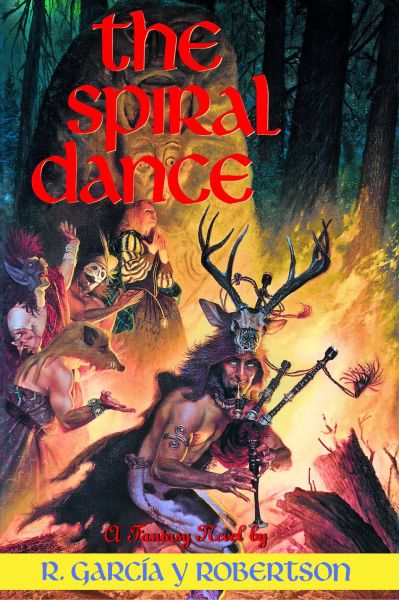In It To Win It
The Spiral Dance
By R. Garcia y Robertson

21 Mar, 2024
R. Garcia y Robertson’s 1991 The Spiral Dance is a stand-alone historical fantasy.
Outraged by Tudor excess, Anne Percy, Countess of Northumberland and her vacillating husband Thomas Percy, the 7th Earl, launch what will be later known as the Northern Rebellion. Leading a rabble comprised of a poorly organized cross-section of the ungovernable north, the aristocratic couple march south to replace hateful Elizabeth with Mary, Queen of Scots. A great victory is assured!
But first, there’s the matter of the mad woman claiming to be Anne Percy, Countess of Northumberland.
To be fair, the mad woman could be Anne Percy’s older sister or perhaps an aged twin. However, Anne Percy being Anne Percy, she is confident that the mad woman is not Anne Percy, no matter what deranged bafflegab the lunatic utters to support her claim. A lunatic could be good luck, used correctly, so Anne adds the mad woman to her entourage as her designated Fool.
While the initial stages of the march south go well enough, the rebels encounter unexpected setbacks. Inexplicably, the key to a successful invasion of the south is not planning that consists of optimistic hand-waving, for an alliance of the foolish with the untrustworthy. As soon as Tudor forces begin to resist, the Percys’ allies begin in vanish. In the end, their grand force proves a fragile bubble.
Believing that distance between themselves and a Queen Elizabeth not known for forgiveness or mercy is prudent, Anne and Tom flee north towards Scotland. The border Scots to whom they turn for refuge are untrustworthy scoundrels. Anne manages to escape. Tom is captured. Once the details of his sale to Queen Elizabeth can be hammered out, his fate will no doubt be grim.
The prudent course of action at this juncture would be for Anne to flee to some safely Catholic nation on the Continent, beyond Elizabeth’s reach. To do so, Anne must elude robbers (which she fails to do), avoid would-be captors, escape fanatical witch-hunters determined to condemn her for witchcraft, resist the advances of amorous werewolves, and avoid irreversible entanglement in supernatural affairs far from her preferred Catholicism.
Alas for Anne, the north of England and Scotland is a land of superstitious brutes as violent as they are conniving and untrustworthy. Survival is unlikely. Even if she lives. the uncanny pagan gods will have their way with pious Anne.
~oOo~
Garcia has a Ph.D. in history so I assume any deviations from historical fact are purposeful. Nevertheless, the text seems to suggest that Anne was childless, having lost both babies. In fact, the couple appears to have had five children, four of whom survived to adulthood.
While many of the specific events in this book (especially the supernatural ones) did not happen as depicted, the general shape of events is correct. Tom and Anne really did set out on an ill-omened, poorly planned expedition south and it really did all fall apart as soon as a Tudor soldier sneezed in their direction. Nothing good happened to Tom, although Anne did escape to weave papist plots.
A question anyone exposed to Scottish history eventually asks is “why on Earth did they think that was a good idea?”, sometimes accompanied by “surely you jest?” Honestly, I don’t know why Scotland excelled in exceedingly wretched decision-making, although compulsive backstabbing and a planning horizon of about thirty seconds seem to have been factors. In the Scots’ defense, China’s Song Dynasty was worse.
Garcia manages the difficult trick of presenting Anne sympathetically while also making it clear that the Northern Rebellion was pure folly. It helps that almost everyone around her is worse1 in some way or other. Anne might be foolish and overconfident, but at least she doesn’t rob and abandon her allies, she never snips fingers off servant girls, and she is, however reluctant she might be to do so, able to learn from experience.
1991 is longer ago than memory suggests, and this novel follows the conventions of the 1970s (just twelve years earlier); it would not have been written this way today. This is a comparatively short novel, about 240 pages in paperback. The work is crammed with events. Half a decade later, in the hands of a different author, and this could have been a five-volume, unfinished series. Modern readers used to flabbier, less disciplined fantasies may find this an intense reading experience.
The Spiral Dance is out of print.
1: In his afterword, Garcia describes European nations of this time as “totalitarian theocracies.” Fair enough.
